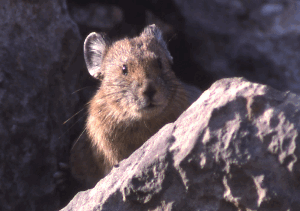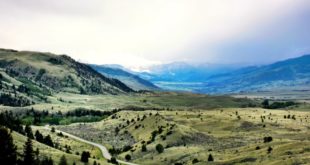The pika is among the most defenseless of the amazing variety of animals inhabiting Yellowstone National Park. Pikas are small rodents limited to higher altitudes who spend most of their time hiding in rocky terrain. Larger predators like eagles, owls and fox feast on the little critters — when they can find them, as their numbers have been dwindling in recent years. We first covered the plight of the poor pika in August.
According to Chris Ray, who is leading a research team from the University of Colorado, increasing temperatures in Yellowstone is causing a drop in pika numbers. “Ironically,” Ray told NPR, “it looks like global warming might be resulting in pikas freezing to death.”
The issue: warming temperatures has cut back on the snow cover high in the mountains. Snow, interestingly, acts as an insulator for the pike in wintertime, given them critical shelter during subzero temperatures. Less snow means less insulation, and less insulation means more pikas freezing to death.
Combine that with higher temperatures in the summer, which cause pika to stay in their rocky shelters, and you have pika potentially starving to death.
Armed with Ray’s data, the Center for Biological Diversity filed a petition to add the pika to the Endangered Species List.
That petition was denied by the U.S. Fish and Wildlife Service, whose scientists determined that temperatures will not rise to the point where pikas threatened. Here’s the official word from the FWS:
Although the American pika is potentially vulnerable to the impacts of climate change in portions of its range, the best available scientific information indicates that pikas will be able to survive despite higher temperatures. Pikas will have enough suitable high elevation habitat to prevent them from becoming threatened or endangered. As a result, the pika does not meet the criteria for protection under the Endangered Species Act (ESA), the U.S. Fish and Wildlife Service announced today after completing a thorough review of the species’ status and evaluating current and future threats to the species.
“We have completed an exhaustive review of the scientific information currently available regarding the status of the American pika and have analyzed the potential threats to the species,” said Steve Guertin, the Service’s Director of the Mountain-Prairie Region. “Based on this information, we have determined that the species as a whole will be able to survive despite increased temperatures in a majority of its range and is not in danger of extinction in the foreseeable future.”
The American pika is a small mountain-dwelling mammal that inhabits loose rock areas in alpine and subalpine mountain areas extending south from central British Columbia and Alberta into the Rocky Mountains of New Mexico and the Sierra Nevada Mountains of California. The historical range of the species includes California, Nevada, Oregon, Washington, Idaho, Montana, Wyoming, Colorado, Utah, and New Mexico.
A key characteristic of the American pika is its temperature sensitivity. Pikas cannot tolerate much higher body temperatures than their norm of 104 degrees Fahrenheit. Therefore, the species is found at progressively higher elevations, where cooler temperatures are found, as one moves south through the range of the species. In Canada, populations occur from sea level to 9,842 feet, but in New Mexico, Nevada, and southern California, populations rarely exist below 8,202 feet.
Based on the most recent information, the five subspecies of American pika are classified as: the Northern Rockies (Ochotona princeps princeps); the Southern Rockies (O.p. saxatilis); the Coastal Mountains and Cascade Range (O.p. fenisex); the Sierra Nevada and Great Basin (O.p. schisticeps); and the Uinta Mountains and Wasatch Range of Central Utah (O.p. uinta).
The Service analyzed potential factors that may affect the habitat or range of the American pika including climate change, livestock grazing, invasive plant species and fire suppression. Climate change was identified as the only potential threat to the species.
The Intergovernmental Panel on Climate Change (IPCC) concludes that human-caused global climate change is occurring and has published research that represents the best available science on the subject. Because most of the IPCC climate change models apply to large, general scales, the Service worked with the National Oceanic and Atmospheric Administration to model historic and future temperatures at a more local scale within the range of the American pika. The models indicate summer temperatures were likely to increase an average of 5.4 degrees Farenheit in pika habitat.
The National Oceanic and Atmospheric Administration generated projections for surface temperatures for 20-year periods and centered on the years 2025, 2050, and 2100. However, the agency stated that because increases in greenhouse gas emissions can be interpreted with greater confidence until approximately mid-century, model projections for the next 30 to 50 years centered on 2050 have greater credibility than results projected further into the future. Therefore, for the purpose of this analysis, the Service centered its foreseeable future projections on the year 2050.
Several climate change variables can affect pika populations, including extremely hot or cold days, average summer temperatures, and duration of snow cover. In general, pika biologists agree that temperatures below the habitat surface, such as in loose rock area crevices, better approximate the conditions experienced by pikas because they rely on subsurface habitat to escape hotter summer daytime temperatures and obtain insulation during the colder winter months. Therefore, surface temperatures may not be as useful as subsurface temperatures for predicting the effects of climate change on pika populations.
Current information indicates that the Northern Rockies, Southern Rockies, Coastal Mountain/Cascade, and Uinta Mountains populations will not be adversely affected by climate change because the majority of pika populations occur at high elevations with correspondingly lower mean temperatures. We have determined that pikas will be able to survive the predicted temperature increases that will occur at these high elevations. Our analysis indicates that predicted temperature increases will not exceed the tolerance of the species or harm its habitat throughout the majority of its range.
The Great Basin population could be affected by climate change along with some lower elevation American pika populations outside of the Great Basin. These populations could be affected because they represent lower elevation sites that will have correspondingly higher mean temperatures by mid-century. Therefore, we expect to continue to see pikas disappear from some low-elevation habitats. However, these losses will not be on the scale that would cause any species, subspecies or distinct population segments of pika to become endangered in the foreseeable future.
Despite the trends of increasing American pika declines in the Great Basin due to increasing temperatures, there is ample evidence that the species can survive and thrive in some habitats with relatively hot surface temperatures. American pika populations thrive at a lower elevation site in the mountains near Bodie, California and in the hot climates of Craters of the Moon (Idaho) and Lava Beds National Monuments (California). Pika persist at these sites because they reduce activity during hot mid-day temperatures by retreating to significantly cooler conditions under the loose rock areas and perform daily activities during the cooler morning and evening periods. Despite altering their behavior in response to high temperatures, pikas can maintain high birth and low mortality rates.
Based on the current information available, the Service finds that the magnitude and imminence of threats do not indicate the American pika is in danger of extinction or likely to become endangered within the foreseeable future throughout all or a significant portion of its range.
Shorter FWS: There will be many pika deaths because of global warming, but not enough to warrant protection of the species.
Extending protected status to a species because of global warming is a controversial move: the state of Alaska is threatening to sue the Feds because of the presence of the polar bear on the Endangered Species list due to global-warming concerns. It also opens a huge can of worms on the regulatory front: you can oppose such a wide swath of development and building on the basis that contributes to global warming and, by extension, the extermination of the American pika. That’s a huge load for a tiny rodent to bear, so it’s no surprise the Fed demurred; the surprise would have been extending protections to the pika.
RELATED STORIES: Climate Change Could Endanger Yellowstone Pika
We’ve also set up a free Twitter account so you can receive updates on the device of your choice.
 Yellowstone Insider Your Complete Guide to America's First National Park
Yellowstone Insider Your Complete Guide to America's First National Park





